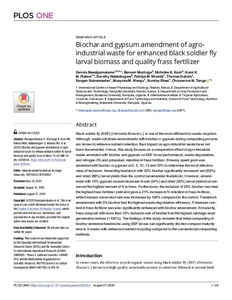| dc.contributor.author | Beesigamukama, D. |
| dc.contributor.author | Mochoge, B. |
| dc.contributor.author | Korir, N.K. |
| dc.contributor.author | Fiaboe, K.K. |
| dc.contributor.author | Nakimbugwe, D. |
| dc.contributor.author | Khamis, F.M. |
| dc.contributor.author | Dubois, T. |
| dc.contributor.author | Subramanian, S. |
| dc.contributor.author | Wangu, M.M. |
| dc.contributor.author | Ekesi, S. |
| dc.contributor.author | Tanga, C.M. |
| dc.date.accessioned | 2021-02-15T11:28:43Z |
| dc.date.available | 2021-02-15T11:28:43Z |
| dc.date.issued | 2021 |
| dc.identifier.citation | Beesigamukama, D., Mochoge, B., Korir, N.K., Fiaboe, K.K., Nakimbugwe, D., Khamis, F.M., ... & Tanga, C.M. (2020). Biochar and gypsum amendment of agro-industrial waste for enhanced black soldier fly larval biomass and quality frass fertilizer. PloS One, 15(8), e0238154, 1-25. |
| dc.identifier.issn | 1932-6203 |
| dc.identifier.uri | https://hdl.handle.net/20.500.12478/7039 |
| dc.description.abstract | Black soldier fly (BSF) (Hermetia illucens L.) is one of the most efficient bio-waste recyclers. Although, waste substrate amendments with biochar or gypsum during composting process are known to enhance nutrient retention, their impact on agro-industrial waste have not been documented. Hence, this study focuses on a comparative effect of agro-industrial waste amended with biochar and gypsum on BSF larval performance, waste degradation, and nitrogen (N) and potassium retention in frass fertilizer. Brewery spent grain was amended with biochar or gypsum at 0, 5, 10, 15 and 20% to determine the most effective rates of inclusion. Amending feedstock with 20% biochar significantly increased wet (89%) and dried (86%) larval yields than the control (unamended feedstock). However, amendment with 15% gypsum caused decrease in wet (34%) and dried (30%) larval yields but conserved the highest amount of N in frass. Furthermore, the inclusion of 20% biochar recorded the highest frass fertilizer yield and gave a 21% increase in N retention in frass fertilizer, while biomass conversion rate was increased by 195% compared to the control. Feedstock amendment with 5% biochar had the highest waste degradation efficiency. Potassium content in frass fertilizer was also significantly enhanced with biochar amendment. At maturity, frass compost with more than 10% inclusion rate of biochar had the highest cabbage seed germination indices (>100%). The findings of this study revealed that initial composting of biochar amended feedstocks using BSF larvae can significantly shorten compost maturity time to 5 weeks with enhanced nutrient recycling compared to the conventional composting methods. |
| dc.description.sponsorship | Canadian International Development Research Centre |
| dc.description.sponsorship | Australian Centre for International Agricultural Research |
| dc.description.sponsorship | Netherlands Organization for Scientific Research |
| dc.description.sponsorship | International Centre of Insect Physiology and Ecology |
| dc.description.sponsorship | UK Aid |
| dc.description.sponsorship | Swedish International Development Cooperation Agency |
| dc.description.sponsorship | Swiss Agency for Development and Cooperation |
| dc.description.sponsorship | Federal Ministry for Economic Cooperation and Development, Germany |
| dc.description.sponsorship | Federal Democratic Republic of Ethiopia |
| dc.description.sponsorship | Kenyan Government |
| dc.format.extent | 1-25 |
| dc.language.iso | en |
| dc.subject | Hermetia Illucens |
| dc.subject | Composting |
| dc.subject | Nutrients |
| dc.subject | Soil Parent Material |
| dc.subject | Wastes |
| dc.subject | Fertilizers |
| dc.title | Biochar and gypsum amendment of agroindustrial waste for enhanced black soldier fly larval biomass and quality frass fertilizer |
| dc.type | Journal Article |
| cg.contributor.crp | Roots, Tubers and Bananas |
| cg.contributor.affiliation | International Centre of Insect Physiology and Ecology |
| cg.contributor.affiliation | Kenyatta University |
| cg.contributor.affiliation | Busitema University |
| cg.contributor.affiliation | International Institute of Tropical Agriculture |
| cg.contributor.affiliation | Makerere University |
| cg.coverage.region | Africa |
| cg.coverage.region | East Africa |
| cg.coverage.country | Kenya |
| cg.coverage.hub | Central Africa Hub |
| cg.researchtheme | Natural Resource Management |
| cg.identifier.bibtexciteid | BEEDIGAMUKAMA:2021a |
| cg.isijournal | ISI Journal |
| cg.authorship.types | CGIAR and developing country institute |
| cg.iitasubject | Agronomy |
| cg.iitasubject | Integrated Soil Fertility Management |
| cg.iitasubject | Soil Fertility |
| cg.iitasubject | Soil Health |
| cg.journal | PLOS ONE |
| cg.notes | Open Access Journal; Published online: 27 Aug 2020 |
| cg.accessibilitystatus | Open Access |
| cg.reviewstatus | Peer Review |
| cg.usagerightslicense | Creative Commons Attribution 4.0 (CC BY 0.0) |
| cg.targetaudience | Scientists |
| cg.identifier.doi | https://dx.doi.org/10.1371/journal.pone.0238154 |
| cg.iitaauthor.identifier | Komi Fiaboe: 0000-0001-5113-2159 |
| cg.futureupdate.required | No |

